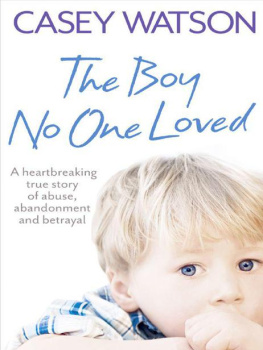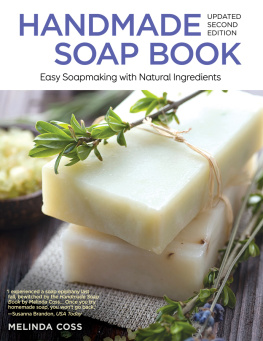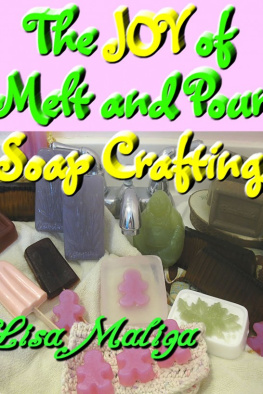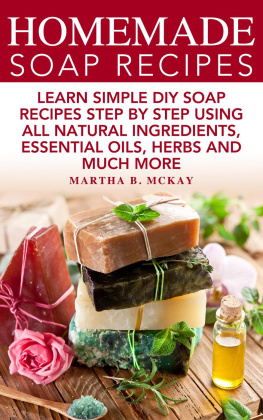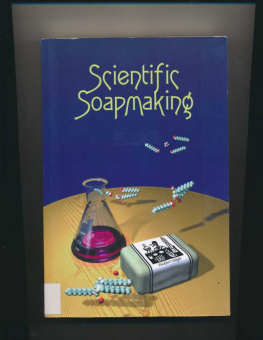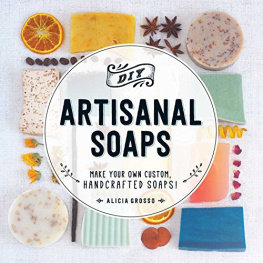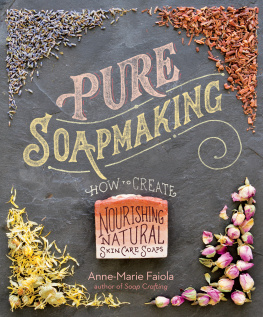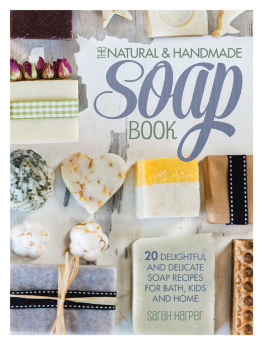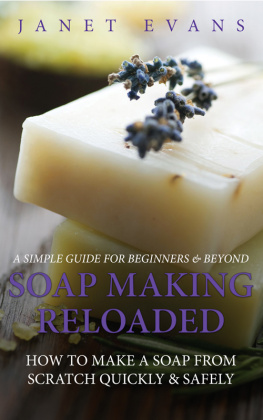Smart Soapmaking
SMART SOAPMAKING
The Simple Guide to Making Traditional Handmade Soap Quickly, Safely, and Reliably, or How to Make Luxurious Handcrafted Soaps from Scratch for Family, Friends, and Yourself
By Anne L. Watson
Illustrated by Wendy Edelson
Shepard Publications
Friday Harbor, Washington
Text copyright 2007, 2013 by Anne L. Watson
Illustrations copyright 2007, 2013 by Shepard Publications
Ebook Version 1.5
Anne L. Watson is the first author to have introduced modern techniques of home soapmaking and lotionmaking to book readers. She has made soap under the company name Soap Tree, and before her retirement from professional life, she was a historic preservation architecture consultant. Anne, her husband, Aaron, and their cat, Skeeter, live in Friday Harbor, Washington.
Soap & Lotion Books
Smart Soapmaking ~ Milk Soapmaking ~ Smart Lotionmaking
Cookbooks
Baking with Cookie Molds
Lifestyle
Living Apart Together
Novels
Skeeter: A Cat Tale ~ Pacific Avenue ~ Joy ~ Flight ~ A Chambered Nautilus ~ Island Women Trilogy (Coming Soon)
For updates and more resources,
visit Annes Soapmaking Page at
www.annelwatson.com/soapmaking
A Few First Thoughts
Make soap when the moon is waning, or it will be harsh.
You have to stir soap clockwise, or it wont set.
Soap has to be stirred with a sassafras stick.
You probably wouldnt believe any of these old superstitions. But soapmaking instructions today can be almost as illogical. They make the process seem complicated and difficult. They make it look terribly dangerous.
It isnt.
Maybe youre like some of my students. Until they took my class, they were afraid to try soapmaking. I love it when the class is finished and they say, Well, of all thingsis that all there is to it?
Or maybe youve made soap, but you wonder if everything you learned to do is really necessary. If theres a simpler way, youd sure like to know.
In either case, Ive been in your shoes. I started out afraid to try soapmaking, and then a friend taught me how. But for a long time I believed a lot of old wives tales about it. I did some things that now seem as silly to me as any of the superstitions I quote above.
When I began to suspect that some of what Id learned was nonsense, I decided to find out what was true and what wasnt. So I started asking people, and nagging people, and trading soap for technical information. I barged around the Internet and bugged librarians and teachers. I studied soapmaking books, watched a video, and even learned computer programs, all to see what different people had to say about the things I wanted to know. Good thing Im a grownupif I were a kid, people would have told me I was a pest. As it was, they probably just thought it.
When I couldnt get answers any other way, I experimented on my own. What will happen if I dont follow this rule? Sometimes, nothing. Bye-bye, rule. More often, though, I found that techniques useful for babying particular recipes had been cast as rules to apply to all. In this book, I tell you when youre likely to need such techniques and when you can skip them.
One of the main things that I learned was to not blindly accept what I was told. Short of sticking my finger into a lye solution to see if it really would burn meand dont you do that, eitherI tested nearly everything. So, unlike some soapmaking books, this one isnt based on handed-down information. Its based on things Ive tried. Once in a while, I do accept someones word for something, but when I do, Ive been careful to say so.
On the other hand, Im not equipped to run a testing lab. Im certain of my results for the recipes and batch sizes Ive worked with. Other ingredients or quantities may give different results. So, go by the book at first, then experiment further if you like.
Or skip the experimenting and just make soap.
Superstitions Galore!
Myths about Soap and Soapmaking
There are a great many misconceptions about soapmaking. Lets take time to dispel some of them, starting with a few that make people afraid to make soap.
Myths That Scare You Away
Myth #1: Soapmaking is difficult.
I stirred that pot for two days, and I never did get it to make soap.
When I was fairly new to making soap, I joined a couple of Internet mailing lists for soapmakers. The messages included lots of Help! emails from people who had been stirring a batch for hours or days and couldnt make it work.
I wondered how they did it. How do you get a batch of soap to fail? I couldnt think of a polite way to ask.
Years later, I posed this question to a group of experienced soapmakers. They agreed that by far the most common cause of Help! emails is that new soapmakers try to design their own recipes before they know how. Making soap and designing recipes are two different crafts. Its best to learn them one at a time. So start with recipes that are tried and true.
Some of those writers of Help! messages may have unknowingly picked difficult recipes. A theme youll find over and over in this book is that different soap recipes vary dramatically in what it takes to make them. Some are easy and some arent. And just because a recipe is harder doesnt mean the soap it makes is better. Ill show you how to figure that out in advance.
Myth #2: Soapmaking is expensive.
You need all this special equipment, and the ingredients cost a lot too.
Were not setting up a factory here. Aside from a couple of special items, soapmaking uses more or less the same tools that cooking does. Many soapmakers use their regular kitchen equipment, and do it safely. Yes, youre using lye, but lye isnt plutonium. Its easily neutralized, diluted, and removed. If you wash your equipment carefully, theres no reason not to use your kitchenware. Carefully is the key word hereyou dont want soap in the soup, or soup in the soap.
But the idea still bothers some people. And some materials, such as aluminum, tin, and copper, work fine for cookware, but you cant use them in soapmaking because they react with lye. So you may not want or even be able to use some things from your kitchen.
If you buy pots, look for stainless or enameled steel. Enameled steel spatterware is usually inexpensive. Restaurant supply stores often have great prices on stainless steel pots.
Your other tools and containers may be stainless steel, enameled steel, heat-resistant plastic, or oven-safe glass. Chances are, you have plenty of usable stuff in your cabinets and drawers. If youre not sure a plastic container is heat-resistant, fill it with boiling water. If you decide to buy equipment, shop aroundbest of all, visit a thrift store (charity shop, in the U.K.), discount store, or dollar store.


